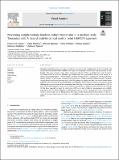| dc.contributor.author | Ngure, Francis | |
| dc.contributor.author | Makule, Edna | |
| dc.contributor.author | Mgongo, William | |
| dc.contributor.author | Phillips, Erica | |
| dc.contributor.author | Kassim, Neema | |
| dc.contributor.author | Stoltzfus, Rebecca | |
| dc.contributor.author | Nelson, Rebecca | |
| dc.date.accessioned | 2024-05-22T08:17:07Z | |
| dc.date.available | 2024-05-22T08:17:07Z | |
| dc.date.issued | 2024-03-22 | |
| dc.identifier.uri | https://doi.org/10.1016/j.foodcont.2024.110463 | |
| dc.identifier.uri | https://dspace.nm-aist.ac.tz/handle/20.500.12479/2642 | |
| dc.description | This research article was published by Elsevier, 2024. | en_US |
| dc.description.abstract | Designing and implementing processing procedures for producing safe complementary foods in dynamic and
unregulated food systems where common food staples are frequently contaminated with mycotoxins is chal-
lenging. This paper presents lessons about minimizing aflatoxins (AF) in groundnut flour and AF and/or
fumonisins (FUM) in maize and groundnut pre-blended flour for complementary feeding in the context of a
dietary research intervention in rural Tanzania. The flours were processed in collaboration with Halisi Products
Limited (Halisi), a medium scale enterprise with experience in milling cereal-based flours in Arusha, Tanzania.
Using a hazard analysis critical control point (HACCP) approach for quality assurance, two critical control points
(CCPs) for AF in processing the pre-blended flour were identified: 1) screening maize before procurement, and 2)
blending during the processing of each constituent flour. Blending of maize flour was also identified as a CCP for
FUM. Visual inspection during screening and sorting were identified as important control measures for reducing
AF, but these steps did not meet the criteria for a CCP due to lack of objective measurement and verifiable
standards for AF. The HACCP approach enabled the production of low AF (<5 μg/kg) and FUM (<2 μg/g) flours
with low rejection rates for the final products. The paper presents practical lessons that could be of value to a
range of commercial processors in similar low- and middle-income contexts who are keen on improving food
quality. | en_US |
| dc.language.iso | en | en_US |
| dc.publisher | Elsevier | en_US |
| dc.subject | Aflatoxins | en_US |
| dc.subject | Fumonisins | en_US |
| dc.subject | Food safety | en_US |
| dc.subject | Hazard analysis | en_US |
| dc.subject | HACCP | en_US |
| dc.subject | Maize | en_US |
| dc.subject | Groundnuts | en_US |
| dc.subject | Sorting | en_US |
| dc.title | Processing complementary foods to reduce mycotoxins in a medium scale Tanzanian mill: A hazard analysis critical control point (HACCP) approach | en_US |
| dc.type | Article | en_US |

